ニュルンベルク医師裁判
ニュルンベルク医師裁判
ニュルンベルク医師裁判は、ニュルンベルグ「医者 裁判」とも言われる。12あったニュルンベルグ継続裁判/ ニュルンベルク継続裁判(Subsequent Nuremberg Trials)の第一番目の法廷である。。(英: Doctors' Trial、独: Ärzteprozess)「1946年12月9日から1947年8月20日 にかけてアメリカ合衆国がニュルンベルクで行ったナチ戦犯法廷である。ナチス 体制下で重い地位にあった医師や医療関係者、ナチス・ドイツの人体実験や安楽死計画に関与した者たちを裁いた。ニュルンベルク継続裁判と総称される12の 裁判の中で最初に行われた裁判である。23人の被告人が裁かれ、うち7名が絞首刑となった。裁判長はワシントン出身のウォルター・ビールス(Walter B. Beals, 1876-1960)が務めた。その他の裁判官としてフロリダ州出身のハロルド・セブリング(Harold L. Sebring, 1898-1968)、オクラホマ州出身のジョンソン・クロフォード(Johnson T. Crawford, 1889-1955)」そしてヴィクター・スウェアリンジェン(Victor C. Swearingen, 1899-1968)。この判決文のなかで、「許可できる医学実験」というものが、ニュルンベルク・コード[ニュルンベルグコード](Nuremberg Code) となった(本サイト「被告リスト:医師裁判とその周辺」)(出典: 「ニュルンベルク医師裁判」ウィキペディア)。
検事総長(Chief of Counsel
for the Prosecution) Telford Taylor,
1908-1998;検事長(chief prosecutor)James
M. McHaney, 1918-1995;
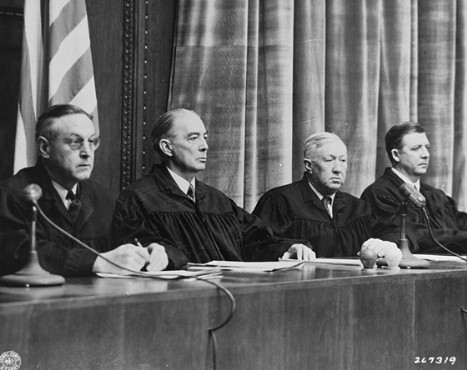
The Nuremberg Military
Tribunal, 1946. From left to right: Harold L. Sebring,
Walter
B. Beals, Johnson T.
Crawford, and Victor C. Swearingen.
1933年7月14日「遺伝病の子孫の予防に関する法」 に基づく殺人計画。同 法は、不適合者を除去することで純粋人種育成を図るナチの構想の一環を成していた。ヒトラーは戦時を待って安楽死計画に着手する腹づもりで、1935年に はその旨の言明を行なっている。。そして1939年9月、総統 官房長フイリップ・ボウラーに命じ、「安楽死」に関し医師たちと協議させ、直 ちに(T4 行動[en Aktion T4, de. Aktion T4] として知られる)作戦を開始する。安楽死計画の対象者は、不治の身体障害者や精神異常者だけにとどまらなかった。その意味から、同計画は人種自体の 根絶を目的とする「最終的解決」の先駆をなすものであった/1939年の終り頃から、精神障害および身体障害を負った成人・小児の殺戮が始められた。しば らくして、自分の子供や親戚が「突然死」に見舞われたり、周囲の障害者の突然死の話を耳にする者が急増した。しかもこれらの死体は、ほとんどの場合、検死 や医学上の検査という理由で親族の自由にならなかった。たちまちにして、殺戮のうわさが流布した。安楽死計画を中止に追い込んだのは、1941年にミュン スター大司教クレメンス・フォン・ガーレン(Clemens August Graf von Galen, 1878-1946)が勇敢にも同計画を非難したことと並び、流布したうわさのせいであったと思 われる。殺戮が止む1972年まで に、約7万5000人が精神病院から連れ去られて殺された」。
"Bishop
von Galen's
selective opposition to elements of National Socialism never amounted
to solidarity with excluded groups such as the Jews however, and whilst
he spoke out against the euthanasia project he was silent on the
equally important issues of roundups, deportations and mass murder of
Jews.[6, Bishop von Galen, German Catholicism and National Socialism,
Beth A. Griech-Polelle, p.22]" - Bishop
von Galen.
| ■ニュー
ルンベルグ・コード 1.被験者の自発的な同意が絶対に必要である。 このことは、被験者が、同意を与える法的な能力を持つべきこと、圧力や詐欺、欺瞞、脅迫、陰謀、その他の隠された強制や威圧による干渉を少しも受けること なく、自由な選択権を行使することのできる状況に置かれるべきこと、よく理解し納得した上で意思決定を行えるように、関係する内容について十分な知識と理 解力を有するべきことを意味している。後者の要件を満たすためには、被験者から肯定的な意思決定を受ける前に、実験の性質、期間、目的、実施の方法と手 段、起こっても不思議ではないあらゆる不都合と危険性、実験に参加することによって生ずる可能性のある健康や人格への影響を、被験者に知らせる必要があ る。 同意の質を保証する義務と責任は、実験を発案したり、指揮したり、従事したりする各々の個人にある。それは、免れて他人任せにはできない個人的な義務であ り責任である。 2.実験は、社会の福利のために実り多い結果を生むとともに、他の方法や手段では行えないものであるべきであり、無計画あるいは無駄に行うべきではない。 3.予想される結果によって実験の遂行が正当化されるように、実験は念入りに計画され、動物実験の結果および研究中の疾患やその他の問題に関する基本的な 知識に基づいて行われるべきである。 4.実験は、あらゆる不必要な身体的、精神的な苦痛や傷害を避けて行われるべきである。 5.死亡や障害を引き起こすことがあらかじめ予想される場合、実験は行うべきではない。ただし、実験する医師自身も被験者となる実験の場合は、例外として よいかも知れない。 6.実験に含まれる危険性の度合いは、その実験により解決される問題の人道上の重大性を決して上回るべきではない。 7.傷害や障害、あるいは死をもたらす僅かな可能性からも被験者を保護するため、周到な準備がなされ、適切な設備が整えられるべきである。 8.実験は、科学的有資格者によってのみ行われるべきである。実験を行う者、あるいは実験に従事する者には、実験の全段階を通じて、最高度の技術と注意が 求められるべきである。 9.実験の進行中に、実験の続行が耐えられないと思われる程の身体的あるいは精神的な状態に至った場合、被験者は、実験を中止させる自由を有するべきであ る。 10.実験の進行中に、責任ある立場の科学者は、彼に求められた誠実さ、優れた技能、注意深い判断力を行使する中で、実験の継続が、傷害や障害、あるいは 死を被験者にもたらしそうだと考えるに足る理由が生じた場合、いつでも実験を中止する心構えでいなければならない。 翻訳:笹栗俊之(福岡臨床研究倫理審査ネットワーク) |
■The
Nuremberg Code 1.The voluntary consent of the human subject is absolutely essential. This means that the person involved should have legal capacity to give consent; should be so situated as to be able to exercise free power of choice, without the intervention of any element of force, fraud, deceit, duress, over-reaching, or other ulterior form of constraint or coercion; and should have sufficient knowledge and comprehension of the elements of the subject matter involved, as to enable him to make an understanding and enlightened decision. This latter element requires that, before the acceptance of an affirmative decision by the experimental subject, there should be made known to him the nature, duration, and purpose of the experiment; the method and means by which it is to be conducted; all inconveniences and hazards reasonably to be expected; and the effects upon his health or person, which may possibly come from his participation in the experiment. The duty and responsibility for ascertaining the quality of the consent rests upon each individual who initiates, directs or engages in the experiment. It is a personal duty and responsibility which may not be delegated to another with impunity. 2.The experiment should be such as to yield fruitful results for the good of society, unprocurable by other methods or means of study, and not random and unnecessary in nature. 3.The experiment should be so designed and based on the results of animal experimentation and a knowledge of the natural history of the disease or other problem under study, that the anticipated results will justify the performance of the experiment. 4.The experiment should be so conducted as to avoid all unnecessary physical and mental suffering and injury. 5.No experiment should be conducted, where there is an a priori reason to believe that death or disabling injury will occur; except, perhaps, in those experiments where the experimental physicians also serve as subjects. 6.The degree of risk to be taken should never exceed that determined by the humanitarian importance of the problem to be solved by the experiment. 7.Proper preparations should be made and adequate facilities provided to protect the experimental subject against even remote possibilities of injury, disability, or death. 8.The experiment should be conducted only by scientifically qualified persons. The highest degree of skill and care should be required through all stages of the experiment of those who conduct or engage in the experiment. 9.During the course of the experiment, the human subject should be at liberty to bring the experiment to an end, if he has reached the physical or mental state, where continuation of the experiment seemed to him to be impossible. 10.During the course of the experiment, the scientist in charge must be prepared to terminate the experiment at any stage, if he has probable cause to believe, in the exercise of the good faith, superior skill and careful judgement required of him, that a continuation of the experiment is likely to result in injury, disability, or death to the experimental subject. source: http://www.med.kyushu-u.ac.jp/recnet_fukuoka/houki-rinri/nuremberg_original.html . |
ヘルマン・ベッカー=フライゼンク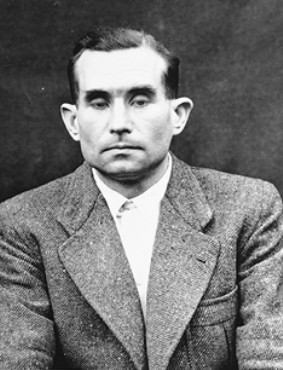 w125 |
Hermann
Becker-Freyseng, 1910-1961 |
ドイツ空軍軍医大尉 - "Becker-Freyseng was initially recruited by Hubertus Strughold to take part in the Nazi human experimentation programme that he oversaw. Becker-Freyseng's particular area of experimentation was low-pressure-chamber research, in which he worked alongside Ulrich Luft, Otto Gauer and Erich Opitz.The Department for Aviation Medicine was established in 1936 with Becker-Freyseng initially just attached before he was promoted to co-ordinator.Unlike some of his colleagues in military medical research, he was a member of the Nazi Party. He also held the rank of Captain in the Medical Service." |
ヴィルヘルム・バイグルベック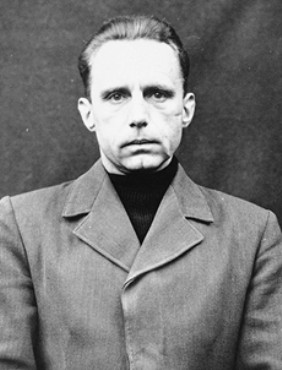 |
Wilhelm
Beiglböck, 1905-1963 |
ドイツ空軍顧問内科医 (関係者→「カール・ヘーレンライナー」) 1944年7月から9月)ダッハウで40名の被験者をつかった人体実験に従事。この研究の責任者は「ヴィルヘルム・バイグルベック」 - "In 1944 he became extrabudgetary professor at the Vienna university. During the war he performed medical tests involving seawater on inmates at Dachau concentration camp." 1944年5月 海水飲用についての議論がはじまる。 - "In May 1944 questions were discussed in the Reich Ministry of Aviation on the drinkability of seawater. The background was the survival of German pilots sailing in the sea. Two methods were available: the method of the Viennese air force engineer Eduard Berka, which masked the salty taste and should improve the alleged excretion of salt by vitamins, and the method of the physician Konrad Schäfer, which reduced the salt content chemically. In order to make the decision, human experiments were planned; As damage to health and possibly death was to be expected, the choice fell on concentration camp prisoners. These were exclusively Roma. The experimental design was undertaken by Hermann Becker-Freyseng, Beiglböck. [3]Among the concentration camp prisoners who had to undergo the experiments include, for example, the German Sinti Jakob Bamberger, Karl Höllenreiner, Josef Laubinger and Ernst Mettbach. [6]" (「原 文」ドイツ語) |
クルト・ブローメ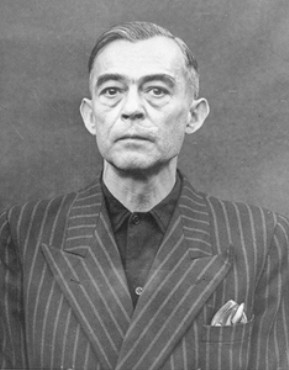 |
Kurt Blome, 1894-1969 |
全国保健指導者代理 "As Plenipotentiary for Cancer Research in the Third Reich, Blome had a longstanding interest in the "military use of carcinogenic substances" and cancer-causing viruses. According to Ute Deichmann's book Biologists under Hitler, in 1942 he became director of a unit affiliated with the Central Cancer Institute at the University of Posen (Poznań in Poland, annexed by Germany in 1939). Although he claimed that the work at this institute involved only 'defensive' measures against biological weapons, Heinrich Himmler, Herman Goering, and Erich Schumann (1898-1985), head of the Wehrmacht's Science Section, strongly supported the offensive use of chemical and biological weapons against Britain, the Soviet Union, and the United States. In 1943, Schumann wrote to Dr. Heinrich Kliewe (1892-1969), one of the Wehrmacht's biological warfare experts that "in particular, America must be attacked simultaneously with various human and animal epidemic pathogens as well as plant pests."[3] According to Kliewe, plague, typhoid, cholera and anthrax were being developed as weapons, as well as a new "synthetic medium for the spread of these bacteria" which would allow them to remain virulent for eight to twelve weeks.[4]2Kurt Blome) "As part of the Nazi biological warfare program code-named Blitzableiter (Lightning Rod, 避雷針), Blome's institute was therefore "a camouflaged operation for the production of biological warfare agents", and its construction was overseen by Karl I. Gross, an S.S. officer and specialist in tropical diseases, who had conducted lethal experiments on 1,700 prisoners at the Mauthausen concentration camp.[5- Robert N. Proctor, The Nazi War on Cancer. Princeton University Press, 1999, pp. 262-63] It was surrounded by a ten-foot high wall, guarded by a special S.S. unit, and designed to prevent the accidental release of the various biological agents being produced there. By May 1944, the institute had sections devoted to physiology-biology, bacteriology and vaccines, radiology, pharmacology, cancer statistics and a tumor farm, and had received at least 2.7 million Reichsmarks in funding from the Wehrmacht and S.S. in 1943–45.[6]2Kurt Blome) "Blome worked on methods of storage and dispersal of biological agents like plague, cholera, anthrax, and typhoid, and also infected prisoners with plague in order to test the efficacy of vaccines. At the University of Strassburg, a "special unit" headed by Prof. Eugen von Haagan (1898-1972) and employing researchers like Kurt Gutzeit (1893-1957) and Arnold Dohmen (1906-1980), tested typhus, hepatitis, nephritis, and other chemical and biological weapons on concentration camp inmates.[7] Gutzeit was in charge of hepatitis research for the German Army, and he and his colleagues carried out virus experiments on mental patients, Jews, Russian POWs (Prisoners of war) and Gypsies in Sachsenhausen, Auschwitz and other locations.[8] In October 1944, Himmler also ordered Blome to experiment with plague on concentration camp prisoners.[9]"Kurt Blome) |
フィクトール・ブラック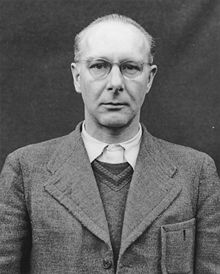 |
Viktor Brack,
1904-1948 |
親衛隊上級大佐 武装親衛隊少佐 - Action T4: "Hauptamt II officials under Viktor Brack played a vital role in organising the killing of mentally ill and physically handicapped people in the Action T4 "euthanasia" programme, especially the child "euthanasia" from 1939.[2] By a (backdated) decree of 1 September,[3] Hitler appointed Philipp Bouhler and his personal physician Karl Brandt to manage the euthanasia program, where they would oversee the murder of physically and/or mentally disabled persons.[4] The implementation of the killing operations were left to subordinates such as Viktor Brack and SA-Oberführer Werner Blankenburg (1905-1957).[5] In December 1939, Brack gave August Becker (1900-1967) the task of arranging gas-killing operations of mentally ill patients and other people whom the Nazis deemed "life unworthy of life". The Action T4 program was related to popular early 20th-century ideas of eugenics and improving the race, not allowing disabled or mentally ill people to reproduce. Initially the doctors in the program sterilized people, then murdered nearly 15,000 German citizens at Hadamar Euthanasia Centre under an extension of this program.[6]"(Viktor Brack) |
カール・ブラント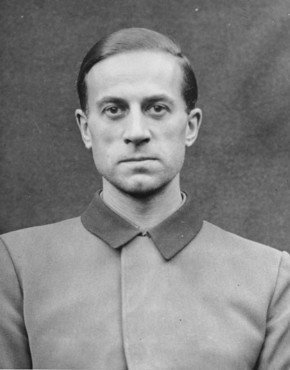 |
Karl Brandt, 1904-1948 |
親衛隊中将 アドルフ・ヒトラー付き内科医 1928 ベルリン大学在学中に州医師試験に合格(30年医師免許) 1932 ナチ入党、ナチドイツ医師連盟会員、翌年SS入隊。 1934 ヒトラー侍医団 1939 10月T4行動の監督(→フィリップ・ボウラーと共に) 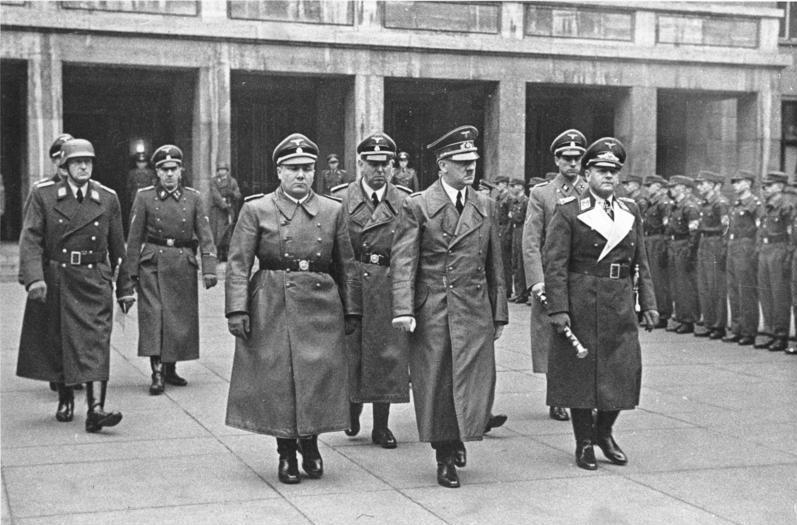 1941年11月28日(最前列:左からボルマン、ヒトラー、ブラント) 1942 国家研究顧問会(Reichsforschungsrat) メンバー、衛生及び保健全権委任者 1943 公衆衛生及び保健全権委員に任命され医学研究においての特別権限を与えられ、強制収容所での人体実験を発案。戦傷者の病棟を確保するために精神障害者の抹殺 作戦wilde Euthanasie(Aktion Brandt)を立案し、指導。 1944 毒ガス防護及び呼吸マスク特別委員会の委員長 1948 最終陳述で、戦争状況における人体実験にインフォームドコンセントなどはありえないと主張。 +++++++++++++++++++++++++++++++++++++++++++++++++ Karl Brandt was born in Mühlhausen, Alsace (then in Germany). He became a medical doctor in 1928. He joined the NSDAP in January 1932, and became a member of the SA in 1933. He became a member of the SS in July 1934 and was appointed Untersturmführer. From the summer of 1934 he was Hitler's personal physician. He received regular promotions from the SS and, by January 1943, Brandt was a major general. In August 1944, Brandt was appointed Reich Commissioner for Sanitation and Health, ranked as the highest Reich authority. He was authorized to issue instructions to the medical organizations of the government, to the party, and the armed forces, in the field of health. He participated in the euthanasia program beginning in 1939, which involved the systematic execution of the aged, insane, incurably ill, or deformed children by gas or lethal injections in nursing homes, hospitals and asylums. They were regarded as 'useless eaters' and a burden to the German war machine. On April 16, 1945, he was arrested by the Gestapo, and was condemned to death by a court at Berlin. He was released from arrest by order of Karl Doenitz on May 2, 1945. On May 23, 1945, he was placed under arrest by the British. Brandt was one of the 15 defendants found guilty of war crimes at the Doctors Trial. He was executed June 2, 1948 at Landsberg prison in Bavaria. |
ルドルフ・ブラント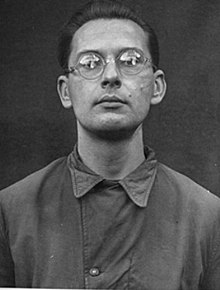 |
Rudolf Brandt,
1909-1948 |
親衛隊大佐 ハインリヒ・ヒムラー個人秘書 内務大臣官房長 「ブラントはまた強制収容所内で行われた親衛隊軍医達による人体実験の調整や 管理を行っていた。アウグスト・ヒルト博士(August Hirt, 1898-1945:敗戦時に自殺)の人種頭蓋骨コレクションのために86人のユダヤ人を殺害したことに関与」ルドルフ・ブラント) |
フリッツ・フィッシャー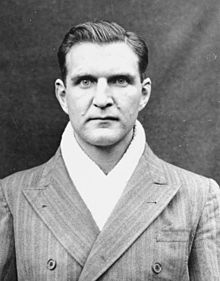 |
Fritz
Fischer, 1912-2003 |
親衛隊少佐 親衛隊内科医 カール・ゲプハルトの副官 「ラーフェンスブリュック強制収容所(Ravensbrück concentration camp) 付きの医師となる。カール・ゲプハルトが同収容所で行った人体実験の助手役を務めた。戦後、アメリカ軍のニュルンベルク継続裁判の一つ医者裁判にかけられ た。終身刑判決を受けたが、1951年に15年に減刑され、1954年に釈放された。戦後は医師免許を返上の上で、インゲルハイム(de: Ingelheim)の化学薬品メーカーベーリンガー社に勤務。インゲルハイムで死去」 |
カール・ゲプハルト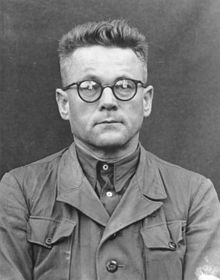 |
Karl Gebhardt,
1897-1948 |
親衛隊中将、親衛隊全国指導者侍医兼主治
医、ドイツ赤十字社副総裁、親衛隊及び警察医師団外科医部長。「1942年8月、ラーフェンスブリュック強制収容所の75人のポーランド人の若い娘を使っ
た人体実験で、ある種のサルファ剤が銃弾を受けたことで引き起こされる感染症に無効力であることを立証するのに成功し、1943年5月の軍事医学会総会で
この実験結果を発表した。ヒトラーはゲープハルトを再評価し、この功績をたたえてヒトラー自らの手でゲープハルトに戦功十字章を授与」(ゲプハルト) |
カール・ゲンツケン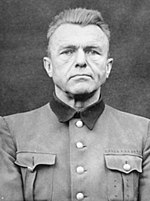 |
Karl
Genzken,1885-1957 |
親衛隊中将 武装親衛隊医師長 「テオドール・アイケが親衛隊髑髏部隊長兼強制収容所総監(Inspekteur der Konzentrationslager)に就任すると、ゲンツケンは 医師長(leitenden Arztes)に就任した。彼が担う任務は収容者らの治療で、各収容所付医師らは医師長たるゲンツケンに対して毎月収容者のうち傷病者らの数や病院棟の状 況などを報告する義務があった。この報告に基いて各収容所への医薬品・衛生物資の供給が行われていたが、ゲンツケンはあえて要求を下回る量の供給しか行わ なかったという[2]。またゲンツケンは断種法である「遺伝病子孫予防法」(Gesetz zur Verhütung erbkranken Nachwuchses)に基いて各収容所に強制不妊手術を行うように命じている。ヴュルツブルクの精神科医ヴェルナー・ハイデ(ドイツ語版)はゲンツケ ンの要請を受けて収容者に対する不妊処置の法的正当性を説く報告書を作成し、遺伝健康裁判所(ドイツ語版)に提出している。/1939年秋から1940年 まで、ゲンツケンは髑髏師団の衛生部に勤務した[3]。1940年4月から敗戦までは武装親衛隊衛生部長官を務めると共に強制収容所収容者に対する各種の 人体実験の責任者であった。ブーヘンヴァルト強制収容所にて腸チフス治療実験を行っていた医師エルヴィン・ディン=シューラーとは個人的な面識があったと いう[4]。なお、1943年までに親衛隊中将(Gruppenführer)及び武装親衛隊中将(Generalleutnant der Waffen-SS)に昇進」ゲンツケン) |
ジークフリート・ハントローザー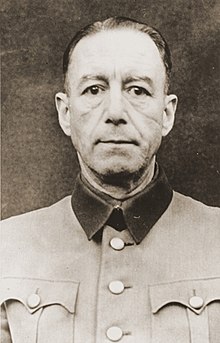 |
Siegfried
Handloser, 1885-1954 |
陸軍軍医大将 国防軍衛生本部長官 |
ヴァルデマール・ホーフェン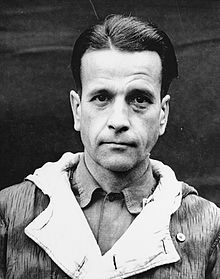 |
Waldemar Hoven,
1903-1948 |
親衛隊大尉 ブーヘンヴァルト強制収容所医師長(Buchenwald concentration camp) |
ヨアヒム・ムルゴウスキー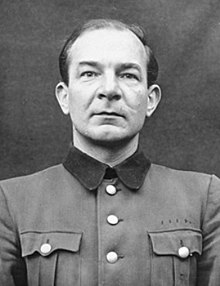 |
Joachim
Mrugowsky, 1905-1948 |
親衛隊上級大佐 医学博士 武装親衛隊衛生協会会長 親衛隊及び警察医師団衛生部長 |
ヘルタ・オーバーホイザー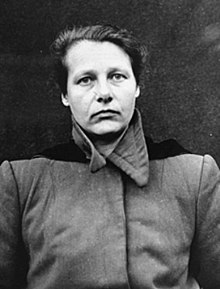 |
Herta
Oberheuser, 1911-1978 |
ラーフェンスブリュック強制収容所女医。
「1940年から1943年にかけて女性用の強制収容所ラーフェンスブリュック強制収容所で収容所医師として働き、同収容所で行われたカール・ゲプハルト
の女性への人体実験に際して助手として働いた。彼女が関与した人体実験の被害者は86人に及び、そのうち74人はポーランド政治犯の女囚であった。また健
康な子供たちを対象に手足や臓器を切り取り、その後Hexobarbital
(Evipan)注射で殺害する実験にも関与。1943年以降、ゲプハルトが院長をしているホーヘンリュッヘ
ン病院(Hohenlychen Sanatorium)に転属。……裁判の中で唯一の女性被告であった」 |
アドルフ・ポコルニー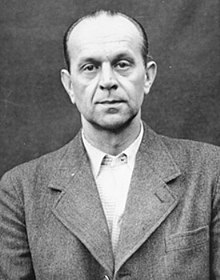 |
Adolf Pokorny,
1895-unknown |
内科医 皮膚と性病の専門家 |
ヘルムート・ポッペンディック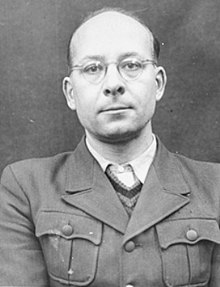 |
Helmut
Poppendick, 1902-1994 |
親衛隊上級大佐 親衛隊内科医 - Kaiser Wilhelm Institute for Anthropology in "Kaiser Wilhelm Society"(カイザー・ヴィルヘルム学術振興協会) |
ハンス・ヴォルフガンク・ロームベルク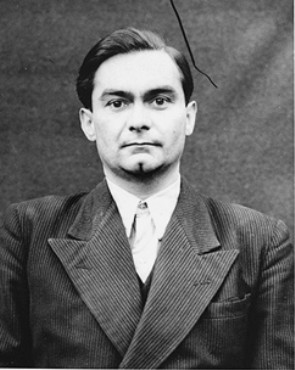 |
Hans
Wolfgang Romberg, 1911-1981 |
ドイツ航空実験協会航空医学部門所属の医
師 1938 zuerst Assistent und später Abteilungsleiter am Institut für Flugmedizin der Deutschen Versuchsanstalt (ドイツ航空研究所) in Berlin-Adlershof unter Siegfried Ruff (1907-1989). 1940 ダッハウ強制収用所にて人体実験に従事。 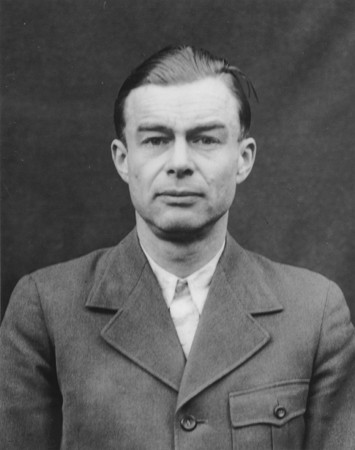 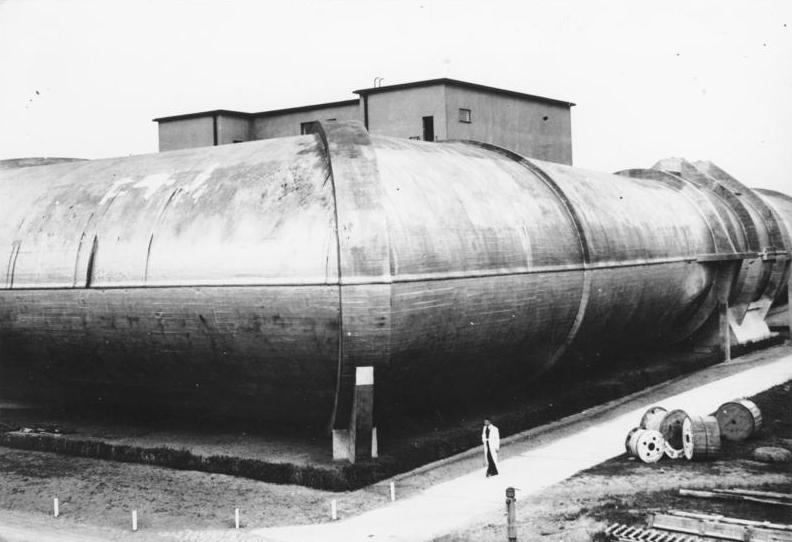 Siegfried Ruff (1907-1989) and Deutschen Versuchsanstalt. |
ゲルハルト・ローゼ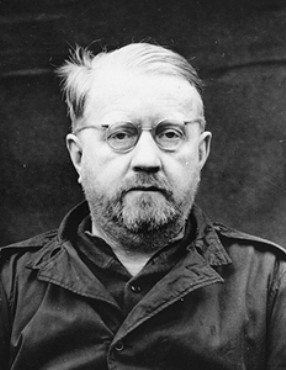 |
Gerhard Rose,
1896-1992 |
空軍軍医少将 熱帯医学部門長 ロベルト・コッホ協会教授 ダッハウとブーヘンヴァルトにて、マラリアとチフスの感染実験に従事。 |
パウル・ロストック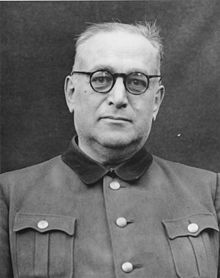 |
Paul Rostock,
1892-1956 |
ベルリン外科医診療所医師 陸軍外科相談役 医学科学研究事務所長 |
ジークフリート・ルフ |
Siegfried Ruff,
1907-1989 |
ドイツ航空実験協会航空医学部門検査官 戦後ハイデルベルクのアメリカ陸箪航空軍の航空医学セ ンターに勤務 [I]n 1961 the International Academy of Aviation and Space Medicine chose to relocate its annual conference from West Germany over objections at Ruff's participation. |
コンラート・シェーファー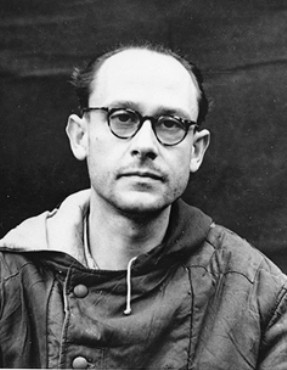 |
Konrad
Schäfer, 1911- (unknown) |
ベルリン航空医学研究所の医師(a
researcher at the Institute for Aviation Medicine in Berlin) 戦後米国の、 U.S. Army Air Forces at Randolph Air Fieldで研究(→リヒトブラウ『ナチスの楽園』)。 - 海水飲用の人体実験への関与に関しては「ヴィルヘルム・バイグルベック」を参照("the method of the physician Konrad Schäfer, which reduced the salt content chemically.")。 |
オスカー・シュレーダー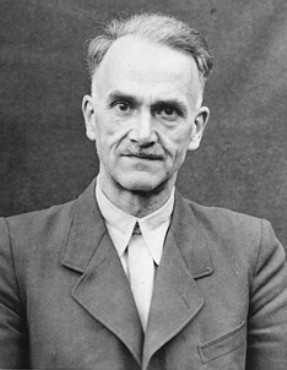 |
Oskar
Schröder,1891-1959. |
空軍軍医大将 空軍医療班検査官部長 空軍医療班長 1942 以降、海水を飲ませる実験をおこない。後に(1944年7月から9月)ダッハウで40名の被験者をつかった人体実験に従事。この研究の責任者は 「ヴィルヘルム・バイグルベック」 |
ヴォルフラム・ジーヴァス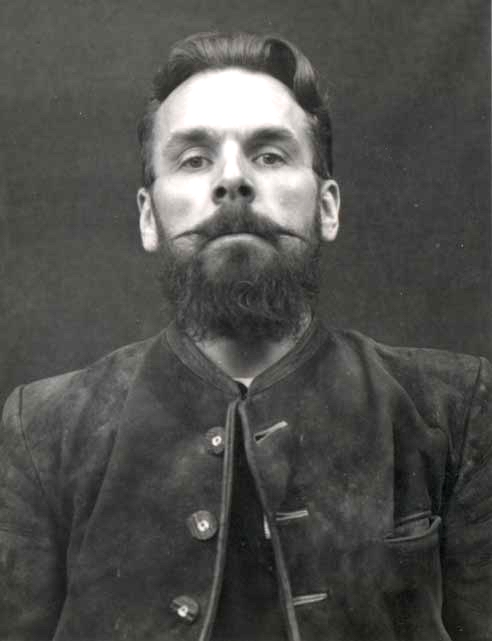 |
Wolfram Sievers,
1905-1948. |
親衛隊大佐,
アーネンエルベ事務長。3審とも有罪(1947年8月20日)死刑。「ストラスブールライヒ大学のアウグスト・ヒルト(August Hirt,
1898-1945)の人種研究のために人骨を集めることに助力した。彼は人骨を集めるためだけに112人のユダヤ人囚人を選び出して殺害。1948年6
月2日にバイエルン州のランツベルク刑務所において絞首刑」ジーヴァス) - アウグスト・ヒルトとの共同研究者。 - ヨーゼフ・クラーマー(ベルゲン・ベルゼン強制収容所所長)より犠牲者 の提供をうける |
ゲオルク・アウグスト・ヴェルツ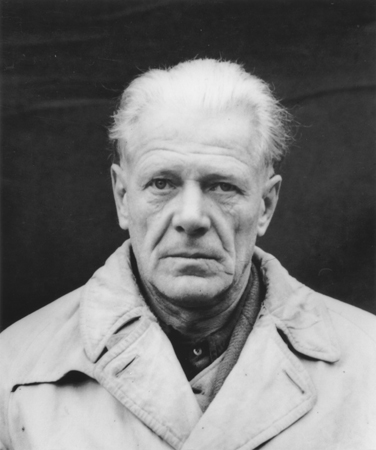 |
Georg August
Weltz, 1889-1963 |
空軍軍医中佐 ミュンヘン航空医学協会会長 1936 ミュンヘン大学講師(放射線医学) 1937 ナチ入党 1939 空軍軍医中佐 1941 ミュンヘンの航空宇宙医学研究所 ニュルンベルク医学裁判で、身長テスト(?双子の?)で訴追、無罪。 |
| 以
下、番
外 |
(医 師裁 判被告にはならなかった。自殺あるい別件裁判) | |
ア
ウグスト・ヒルト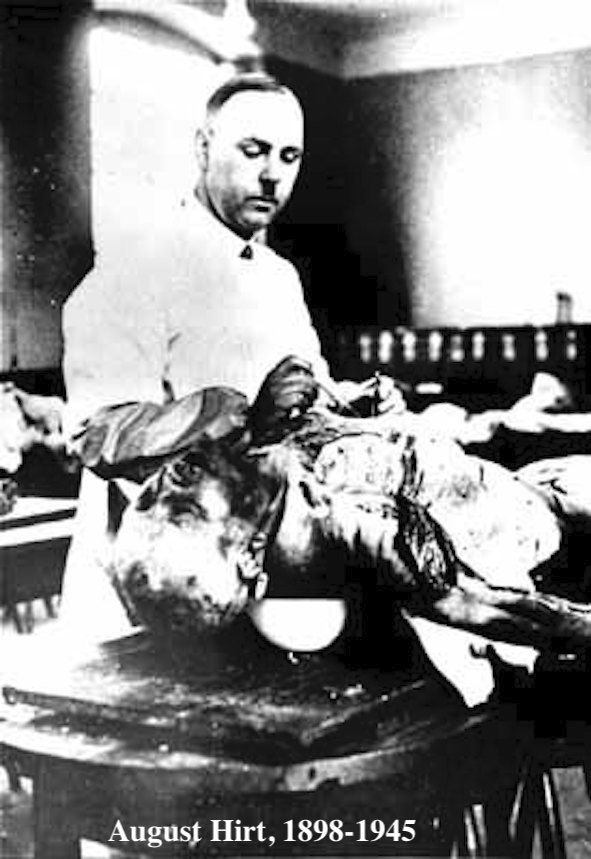 The Denying History Projectより |
August Hirt, 1898-1945 |
スイス=ドイツの解剖学者「第二次世界大
戦中にはシュトラスブルクライ
ヒ大学(de:Reichsuniversität
Straßburg)の長官を務めていた。アーネンエルベのヴォルフラム・ジーヴァスとともに人種研究のためにダッハウ強制収容所の囚人たちを殺害して人
間の頭蓋骨を集めていた。1943年にはアウシュヴィッツ強制収容所の受刑者のうち79
[→86
名]人のユダヤ人男性、30人のユダヤ人女性、2人のポーランド人、4人の
アジア人を確保し、ナッツヴァイラー強制収容所(Natzweiler-Struthof)
へ送還し、ヨゼフ・クラマーにガス殺させたのち、その遺体を使って人体実験を行った。アジア人はソ連兵捕虜から確保したと思われ、彼らはメスカリンの毒としての影響を調べるた
めの人体実験にも使用された。シュヴァルツヴァルトで自殺(1945年6月2日)」ア
ウグスト・ヒルト) - 86 名のユダヤ人犠牲者の氏名(The Denying History Project) |
ヨー
ゼフ・クラーマー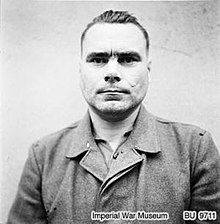 |
Josef Kramer,
1906-1945 |
「1931年ナチ入党。1932年に親衛
隊(SS)の隊員となった。
1934年にはダッハウ強制収容所の看守となった。急速に昇進してザクセンハウゼン強制収容所やマウトハウゼン強制収容所で副所長をつとめた。1940年
にはアウシュヴィッツ強制収容所でルドルフ・ヘス所長の副官となった。1941年4月にはナッツヴァイラー強制収容所の所長に就任する。1942年親衛隊
大尉に昇進。1944年5月から1944年12月にかけてはアウシュヴィッツのガス室の管理を任せられている。1944年12月からベルゲン・ベルゼン強
制収容所の所長となった。同収容所は衛生状態が著しく悪く、この収容所では大勢の囚人がチフス等の感染症や飢えで死亡している。「アンネの日記」の著者ア
ンネ・フランクもその犠牲者の一人である。ベルゼンにおいて解放された収容者によって伝えられた「ユダヤ人が収容所から抜け出すにはこの煙突を通って行く
しかない」と焼却炉を示した言葉は有名。/終戦時、ヨーゼフはベルゼンにおいてイギリス軍に逮捕され、他の44名の所員と共に功罪を問うべくイギリス軍が
リューネブルクで開いた「ベルゼン裁判」にかけられ、処刑」クラーマー) |
| アウグスト・ベッカー |
August Becker,
1900-1967 |
August Becker
"helped design
the vans with a gas chamber built into the back compartment used in
early Nazi mass murder of disabled people, political dissidents, Jews,
and other "racial enemies," including Action T4 as well as the
Einsatzgruppen (mobile Nazi death squads) in the Nazi-occupied portions
of the Soviet Union. Generally his role was to provide important technical support, but on
at least one occasion he personally gassed about 20 people." August Becker) |
| Heinrich Gross,
1915-2005 |
Heinrich Gross
"was an Austrian psychiatrist, medical doctor and neurologist, a
reputed expert as a leading court-appointed psychiatrist, ill-famed for
his proven involvement in the killing
of at least nine children with physical, mental and/or
emotional/behavioral characteristics considered "unclean" by the Nazi
regime, under its Euthanasia Program. His role in hundreds of
other cases of infanticide is unclear.
Gross was head of the Am Spiegelgrund children's psychiatric
clinic for two years during World War II."Gross ) |
|
| ナチ・ドクター・リスト(英
語) |
List of Nazi
doctors |
|
| クルト・グートツァイト |
Kurt Gutzeit,
1893-1957 |
肝炎感染実験 |
フィ
リップ・ボウラー |
Philipp Bouhler,
1899-1945 |
- 総統官房長 - 1939年10月にフィリップ・ボウラーはカール・ブラントとともに障害 者や病人を安楽死させる計画「T4作戦」の監督をヒトラーから任された。 |
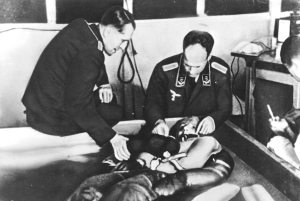 Professor Ernst Holzlöhner (left) |
Ernst
Holzlöhner, 1899-1945 |
Together
with his assistants Sigmund Rascher and Erich Finke, he carried out
sub-cooling experiments on behalf of the Luftwaffe in the Dachau concentration camp
from August 1942, in which prisoners were deliberately chilled to
simulate winter conditions, then reheated using different methods. At
the conference on medical questions in distress and winter death on
October 26 and 27, 1942, he discussed the results of the cold tests. In
April 1945, Holzlöhner was appointed Rector of the University of Kiel. |
 Doctor Sigmund Rascher (right) perform a cold water immersion experiment at Dachau. The subject is wearing an experimental Luftwaffe garment. |
Sigmund
Rascher, 1909-1945 |
Sigmund Rascher
(12 February
1909 – 26 April 1945) was a German SS doctor. He conducted deadly
experiments on humans about high
altitude, freezing and blood coagulation
under SS leader Heinrich Himmler's patronage, to whom his wife Karoline
"Nini" Diehl had direct connections. When police investigations
uncovered that the couple defrauded the public with their supernatural
fertility by 'hiring' and kidnapping babies, she and Rascher were
arrested in April 1944. He was accused of financial irregularities,
murder of his former lab assistant, and scientific fraud, and brought
to Buchenwald and Dachau before being executed. After his death, the
Nuremberg Trials judged his experiments as inhumane and criminal.[1] 1. High altitude experiments 2. Freezing experiments 3. Blood coagulation experiments |
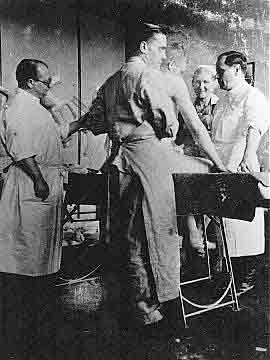 Carl Clauberg (left) ※The Holocaust: Nazi Medical Experiments |
Carl Clauberg,
1898-1957 |
Professor
Dr. Carl Clauberg was born in Wuppertal in 1898 into a craftsmen
family. He participated in World War I as infantryman, later studied
medicine and avanced to doctor-in-chief at the University
gynaecological clinic in Kiel. He entered the NSDAP in 1933 and became
a fanatical supporter of its ideology. In the same year, he was
appointed professor for gynaecology at Koenigsberg University. In 1942, he asked Heinrich Himmler, who had already been interested in Claubergs “research,” to offer him the possibility to sterilize a multitude of people for his experiments. Thus, Clauberg came to Auschwitz in December 1942 and part of Block No. 10 in the Main Camp was put at his disposal.. Looking for a “cheap and efficient” method to sterilize women, he injected acid liquids to their uterus without anaesthetics. Thousands of Jewish and Gypsy women were subjected to this treatment. They were sterilized by the injections, producing horrible pain, inflamed ovaries, bursting spasms in the stomach, and bleeding. The injections seriously damaged the ovaries of the victims, which were then removed and sent to Berlin. Clauberg's experiments killed some of his subjects, and others were put to death so that autopsies could be performed. In June 1943, Clauberg wrote to Himmler: "The non-surgical method of sterilizing women that I have invented is now almost perfected . . . As for the questions that you have directed to me, sir, I can today answer them in the way that I had anticipated: if the research that I am carrying out continues to yield the sort of results that it has produced so far (and there is no reason to suppose that this shall not be the case), then I shall be able to report in the foreseeable future that one experienced physician, with an appropriately equipped office and the aid of ten auxiliary personnel, will be able to carry out in the course of a single day the sterilization of hundreds, or even 1,000 women." Clauberg escaped the approaching Red Army and went to Ravensbruck concentration camp, where he continued his experiments. It was estimated that he had sterilized some 700 women. In 1948, he was put to trial in the Soviet Union and sentenced to 25 years; seven years later, he was pardonned and went back to the Federal Republic of Germany. Upon returning he held a press conference and boasted of his scientific work at Auschwitz. After survivor groups protested, Clauberg was arrested in 1955 but died in August 1957, shortly before his trial should have started. |
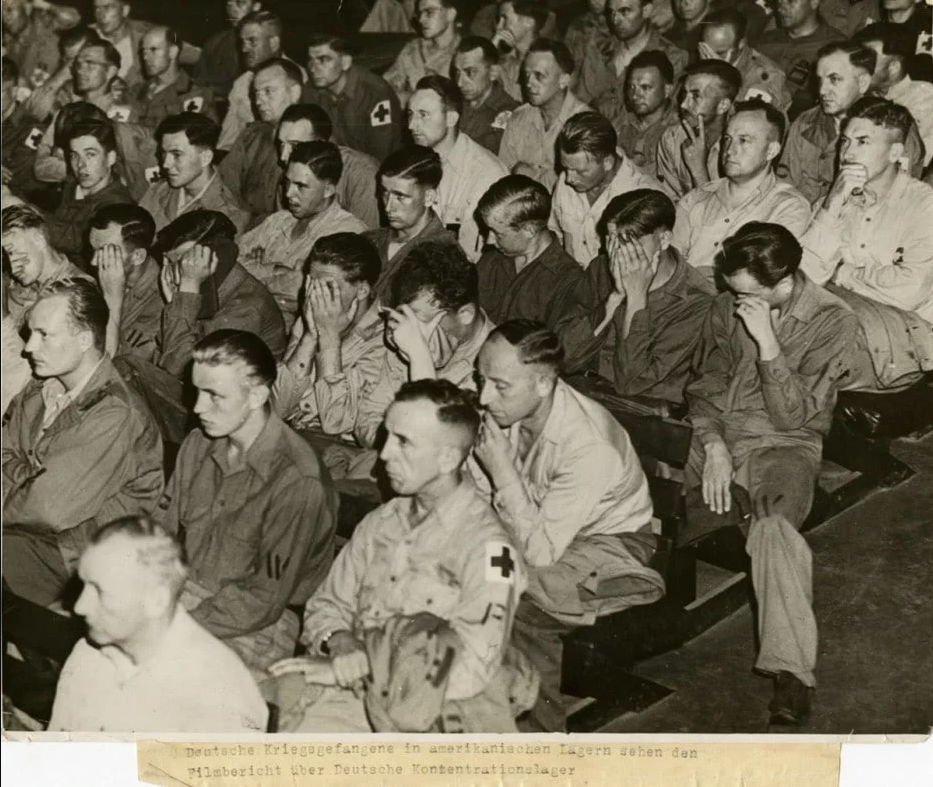 |
ドイツの戦争捕虜たち |
(強制収用所に関わったと思われる)ドイ
ツの戦争捕虜たちが、戦後にそ
の映像フィルムを見せられて顔を背けている写真(出典:不詳)。 |
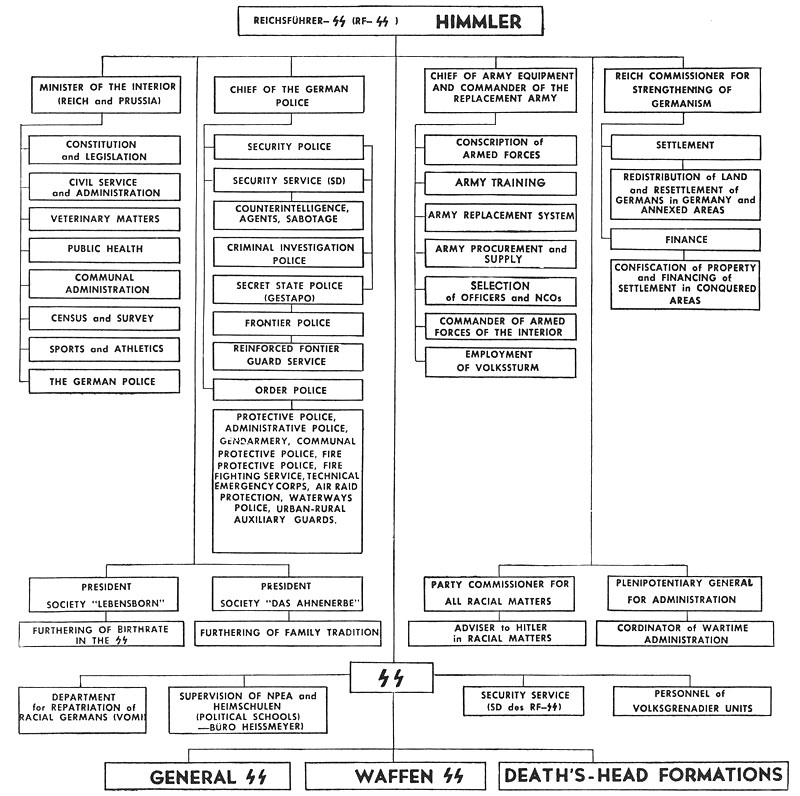
■参照
旧・東ドイツの政治的イデオロギーの観点から、ニュ ルンベルグの戦争犯罪が戦後もきちんと克服されていないという告発はペーター・プシビルスキ(1981)『裁かれざるナチス : ニュルンベルク裁判とその後』を参照のこと。
リンク
文献
その他の情報
Copyleft, CC, Mitzub'ixi Quq Chi'j, 2019
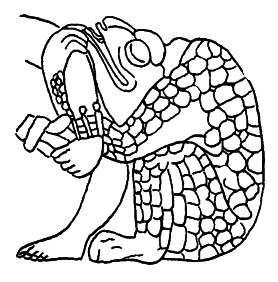
++
Copyleft,
CC, Mitzub'ixi Quq Chi'j, 1996-2099